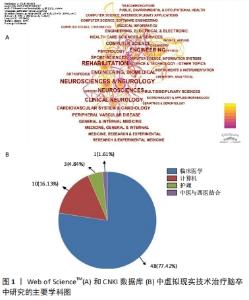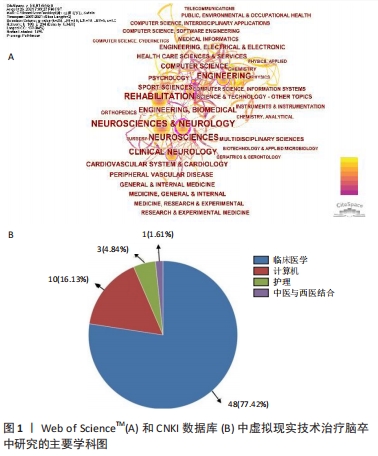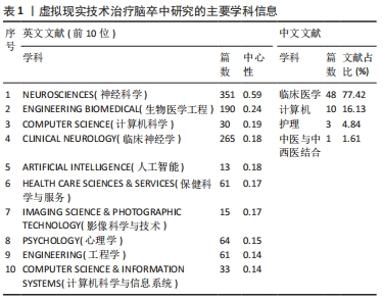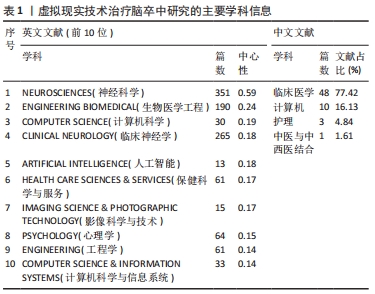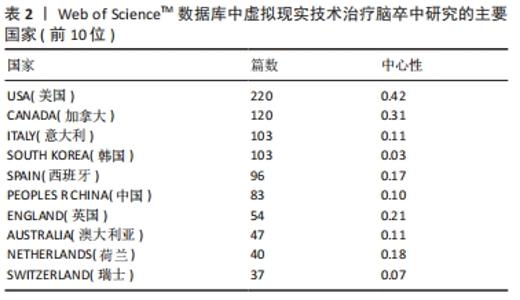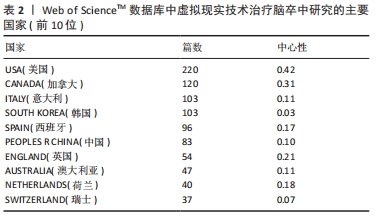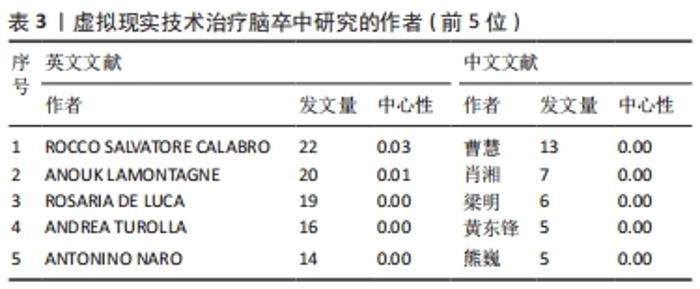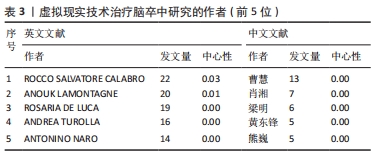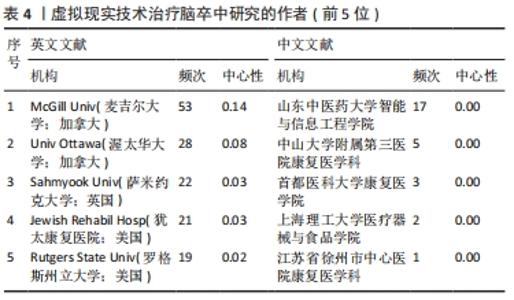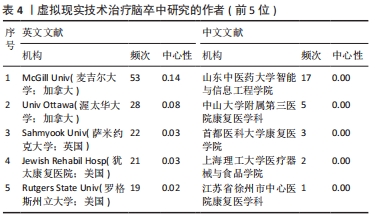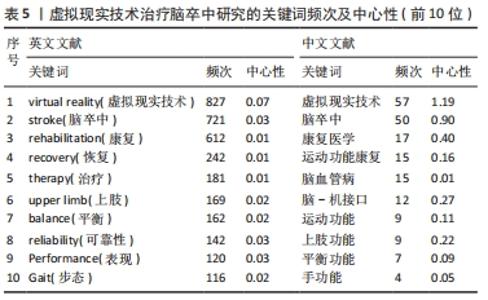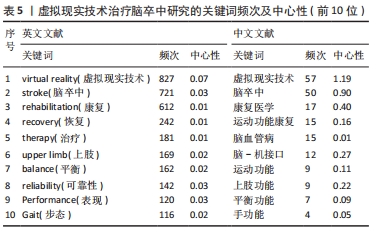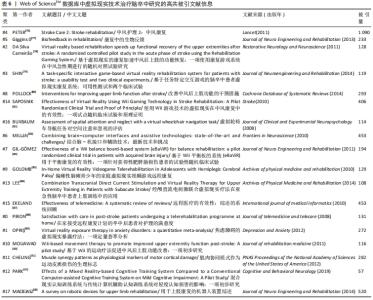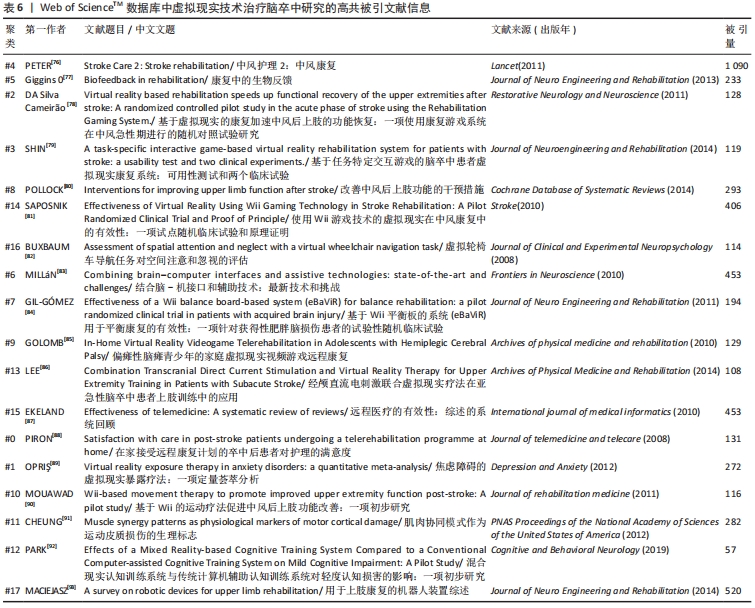Chinese Journal of Tissue Engineering Research ›› 2022, Vol. 26 ›› Issue (26): 4224-4233.doi: 10.12307/2022.828
Previous Articles Next Articles
Knowledge graph analysis of virtual reality technology in stroke treatment
Zou Mengyao1, Wang Junhua2, Qin Pengfei3, Zhong Weihua2
- 1School of Biomedical Engineering, Hubei University of Medicine, Shiyan 442000, Hubei Province, China; 2Department of Rehabilitation, Taihe Hospital Affiliated to Hubei University of Medicine, Shiyan 442000, Hubei Province, China; 3School of Sports Science, Fujian Normal University, Fuzhou 350108, Fujian Province, China
-
Received:2021-08-16Accepted:2021-09-15Online:2022-09-18Published:2022-03-09 -
Contact:Wang Junhua, MD, Professor, Master’s supervisor, Chief physician, Department of Rehabilitation, Taihe Hospital Affiliated to Hubei University of Medicine, Shiyan 442000, Hubei Province, China -
About author:Zou Mengyao, Master candidate, Junior therapist, School of Biomedical Engineering, Hubei University of Medicine, Shiyan 442000, Hubei Province, China -
Supported by:a grant from the Department of Rehabilitation in Taihe Hospital Affiliated to Hubei Uneversity of Medicine, No. 2020JJXM111
CLC Number:
Cite this article
Zou Mengyao, Wang Junhua, Qin Pengfei, Zhong Weihua. Knowledge graph analysis of virtual reality technology in stroke treatment[J]. Chinese Journal of Tissue Engineering Research, 2022, 26(26): 4224-4233.
share this article
Add to citation manager EndNote|Reference Manager|ProCite|BibTeX|RefWorks
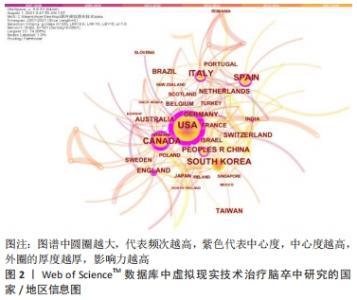
从图1可以看出,虚拟现实技术治疗脑卒中研究的英文文献中涉及的学科较多,而中文文献仅有4种学科,学科数较少。从表1前10位学科来看,英文文献中关键点(中心性Centrality> 0.1)的学科种类较多,且神经科学(0.59)、生物医学工程(0.24)、计算机科学(0.19)的中心性最高,其中神经学科主要研究的是通过虚拟现实技术刺激多感官的神经肌肉活动,从而增强肌肉的运动表现和促进肢体能力的恢复[13-14],生物医学工程主要涉及上肢功能恢复[15]、评估运动能力[16]、虚拟现实环境的开发[17-18]、运动技能的转移4个方面[19],计算机科学则是研究康复场景重塑[20]、构建平衡康复系统[21]、处理信息数据等内容[22]。中文文献中临床医学所占篇数最多,占比达到了77.42%,主要是该技术在现实康复中的应用进展、促进身体运动功能恢复等方面的研究[23]。 表明:①国外虚拟现实技术治疗脑卒中所涉学科较多,其中主要学科是神经科学、生物医学工程和计算机工程,国内涉及的学科较少,主要学科是临床医学;②国外虚拟现实技术治疗脑卒中的学科多样化,并形成了以神经科学、生物医学工程、计算机科学为主的交叉学科群,国内学科则较为单一,未形成明显的交叉学科群;③国外多学科间的相互融合促进了虚拟现实技术治疗脑卒中的快速发展,并形成了质量较高且数量较多的研究成果;国内学科间交流略显乏力,学科视角较为单调,成果数量较少;④从整体的医学防治到精细的病理机制探讨,皆为该技术治疗脑卒中研究提供了多重视角和有力的理论支撑。 2.2 虚拟现实技术治疗脑卒中研究的国家/地区合作可视化 为了更好地了解该领域的重要研究机构位于何处,故对英文文献数据操作如下步骤:①在功能参数区勾选Country(国家);②时间设置为每2年1片,通过Pathfinder裁剪;③运行软件并适当优化后得到最终图谱,见图2。图谱中圆圈越大,代表频次越高,紫色代表中心度,中心度越高,外圈的厚度越厚,影响力越高。"
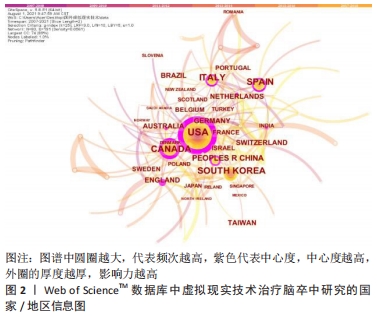
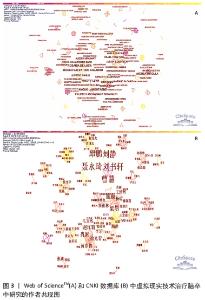
从图2中可以看出国外虚拟现实技术治疗脑卒中研究的国家/地区较多,达到了83个国家/地区,且各国家/地区之间相互交叉,其中美国的频次和中心性最高,加拿大次之。表2显示,美国发文220篇居于第1位,次之是加拿大,发文量是120篇,中国以83篇的发文量处于第6位。美国的中心性最高,为0.42,次之是加拿大(0.31)。表明:①国外虚拟现实技术治疗脑卒中的研究已引起绝大多数国家的重视,各国之间合作交流频繁,并形成以美国、加拿大为主的合作研究群体;②美国在该领域中具有十分重要的地位,且与其他国家合作的次数最多,影响范围较广;③中国在该领域中的发文量(第6)和中心性(第7)占据着一定的优势,虽与多个国家存在合作和交流,但与美国、加拿大相比仍具有不小的差距,缺乏影响力。 2.3 虚拟现实技术治疗脑卒中研究的作者分析 剖析高产作者可以清楚地揭示各作者间的互助情况和发文量。英文文献:①时间设切片为每2年1片;②网络节点选择Author(作者);③勾选Pathfinder算法,运行后得到该研究范畴的作者合作图谱,见图3A。中文文献时间切片为每年1片,其余节点不变,运行后得到相应图谱,见图3B。为更好地剖析作者间的发文量、合作关系等关系,故整理前5位高产作者信息后得到表3。"
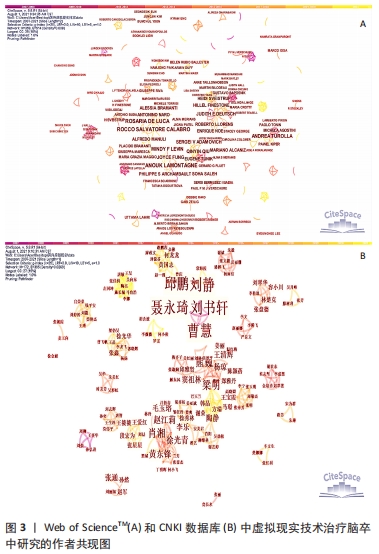
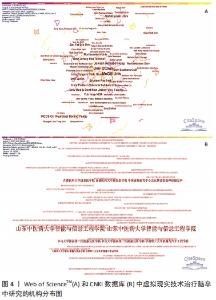
结合图3和表2发现,国外虚拟现实技术治疗脑卒中的研究,各作者、团体间连线较多,说明作者与作者间、团队与团队之间都形成了一定的合作群体,学术交流比较密切。国内也形成了一定的团体,但团体之间连线较少,说明学术交流仅在团体内部,团体与团体之间缺乏学术交流。在英文文献中发文量和中心性最高的是ROCCO SALVATORE CALABRO团队,主要是脑卒中患者认知功能障碍方面的研究[24];中文文献发文量最高的是曹慧团队,主要是该技术的具体应用和总结方面的研究[2]。以上表明:①虚拟现实技术治疗脑卒中研究无论是国内还是国外都形成了合作团体,单一学者的研究较少;②国外各团体之间学术合作交流比较密切,且形成了以ROCCO SALVATORE CALABRO为主的较为有影响力的团队,与之相比,国内各团体之间学术交流较少,成果仅限于自身团体成员之间,缺乏高中心性作者;③团队间发文数量的差异使国内呈现出密切型和松散型2种合作团体,密切型团队例如曹慧、刘静、邱鹏团队;肖湘、徐光青团队等,曹慧团队主要研究虚拟现实技术的具体应用[2];肖湘团队主要涉及脑卒中患者下肢步态功能恢复的研究[25];松散型团队例如容小川、刘翠华、林楚克和张盘德等,主要阐述了虚拟现实技术治疗脑卒中患者上下肢功能障碍的影响和治疗效果[26-27]。 2.4 虚拟现实技术治疗脑卒中研究的机构分析 机构分析可以清楚的了解文章、团队的源头。中英文文献节点,全部勾选机构,其余步骤同上,运行软件后得到相应图谱,见图4,并依据机构出现的频次,选取前5位进行分析,整理数据后得到表4。"
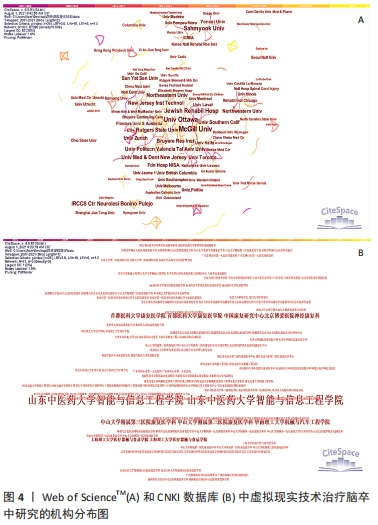
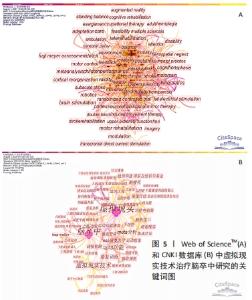
结合图4和表4,英文文献中各机构间联系较多,其中加拿大麦吉尔大学发文量和中心性都是最高的,说明:①各机构之间产生了密切的学术交流与合作,各机构发文数量较多,且大多数产生于大学机构;②各机构之间形成了紧密的学术合作团体,并孕育出以加拿大麦吉尔大学为代表的高发文量和高影响力的机构,促进了该技术的发展;③中文文献各机构间缺乏联系,且多以医院机构为主,发文量较少,缺少高中心性机构,如此可能会影响该技术的发展。提示国内在该技术领域需要加强各机构间的合作与联系,促进该学科技术的快速发展。 2.5 虚拟现实技术治疗脑卒中的研究热点分析 2.5.1 关键词热点 关键词是文章的高度概括和凝练的具体体现,而高频关键词则能展现研究的热点问题[28]。①在功能区,英文文献设置2年1段,中文文献设置每年1段;②勾选Keyword,通过Pathfinder(寻找路径算法)和“Pruning sliced networks”和“Pruning the merged network”2种裁剪方式;③将关键词按照频次由高到低排序,得到关键词图谱,见图5。依据图5发现中外在该技术研究中涉及的关键词数量较多,且各关键词之间相互联系,产生交叉网络,为更好地分析国内外不同的研究热点,故分别选取前10位高频关键词,整理后得到表5。"
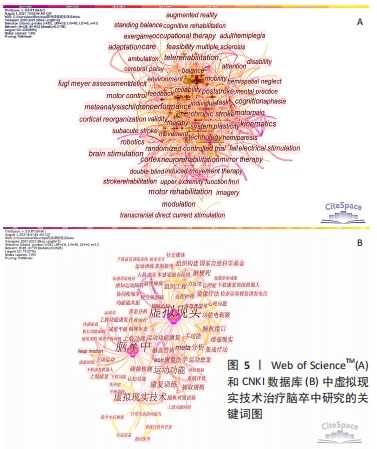
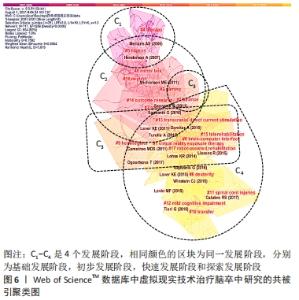
在表5英文文献位于前10位的关键词中,大致可分为康复效果、治疗方法、身体部位3类词组,其中虚拟现实技术和脑卒中的频次最高。整体来看,脑卒中患者上下肢功能的恢复和治疗效果可能是英文文献中研究的热点和重点。从研究内容来看,主要集中于3个主题:①脑卒中患者上肢和下肢运动功能的康复治疗和恢复后效果的研究;②虚拟现实技术在脑卒中患者治疗中的具体应用及效果的研究;③虚拟现实技术与其他技术的结合及对比研究。而虚拟现实技术由于具有较高的中心性,或许可认为是上述全部内容或某一具体内容的主要治疗方法。 据相关研究表明,约85%的初期脑卒中患者有上肢功能障碍[29],且6个月后有30%-36%的患者仍有上肢运动障碍[30],因此如何更好地恢复上肢运动功能便成为英文文献中研究的热点和重点。上肢运动功能的康复治疗主要分为沉浸式、非沉浸式及数据反馈式康复训练模式。沉浸式康复训练模式使用头盔显示器关闭用户的视、听感觉,产生虚拟视觉,同时,它使用数据手套关闭患者的手部感觉通道,产生虚拟的触感。这种康复模式能够使患者的卒中病人运动评分(MAS)和Fugl-Meyer量表上肢运动功能(FMA-UE)得分产生差异性变化[31],且提高了患者的灵巧功能(NPHT)和基本日常生活活动能力(MBI)[32]。同时为防止患者长时间使用而产生疲劳感,CROSBIE等[33]提出该系统的康复时间控制在30-45 min,患者不会感到疲劳,因此对脑卒中患者上肢运动功能的恢复具有良好的效果。 与沉浸式系统相比,非沉浸式康复模式主要是通过大屏幕、手柄游戏机等关联场景中的角色,并利用例如,P5 Glove、Microsoft Kinect运动跟踪设备捕捉和记录运动过程。例如,JIN等[34]学者通过基于非沉浸式虚拟游戏研发出家用上肢康复系统,能够有效改善患者的FMA-UE和MAL[35-36],促进了远程医疗和家庭康复模式的发展。同时有些学者基于非沉浸式系统的开放性,结合例如颈颅直流电刺激[37]、经颅磁刺激[38]、间歇性痛觉刺激等手段作用于大脑皮质建立FC[2,39],帮助患者恢复运动能力。此外还有学者提出基于Leap Motion虚拟现实训练方式,也能够有效促进上肢运动功能的恢复[40]。 数据反馈式康复体系主要是基于数据手套和脑-机接口的2类。数据手套是利用软件编程和传感器,捕捉患者的动作过程并实时的将动作映射到虚拟的环境中,收集相应的数据并评估训练效果,从而帮助患者恢复运动能力,同时摆脱了康复外骨骼的限制,增加了患者的手部伸展度、握力和手指的捏力[41],而且还可应用于家庭康复训练[42]。脑-机接口康复系统则是通过辨别神经活动的模式,解码思维,通过控制系统实时反馈数据给外界设备并和患者大脑产生交流,从而达到康复的目的,这种系统无需患者主动参与,因此更加适用于重度脑卒中患者,提高了患者神经系统的可塑性,能够有效恢复患者的运动功能。此外WILLETT等[43]利用2根微电极阵列芯片,侵入患者脑部捕获神经电信号,借助循环神经网络、主成分分析和非线性降维等方法,将神经电信号可视化,为克服无法准确把握不同程度脑卒中患者的不同疲劳度的难题奠定了基础[44]。 与上肢功能康复相比,下肢平衡功能和正确步态能力的恢复对提高患者的生活质量至关重要,因此下肢运动功能的康复也是学者们关注的热点之一[45]。从研究内容来看,下肢运动功能的康复主要涉及平衡功能和正确步态的恢复2个方面。在平衡功能方面,MARQUES-SULE等[46]将Nintendo Wii这种虚拟的游戏加入到传统的物理治疗中,发现患者在功能[Timed up and go(TUG)]、移动能力[Tinetti Performance-Oriented Mobility Assessment (POMA)]、平衡[Berg Balance Scale (BBS)]都得到了有效改善;ASLAM等[47]通过实验证实,在虚拟现实的平衡训练中,进行30次划桨游戏训练可以很好地改善患者的动态平衡和活动能力,降低了患者的跌倒风险。 此外在该方面也有沉浸式系统和非沉浸式系统,例如,KIM等[48]通过虚拟现实技术(Insta360 ONE X)建立了沉浸式社区街景,得到了较好的治疗效果;ZAKHAROV等[49]在此基础上,通过脚底气动装置还原了虚拟环境中的真实触感,增强了该系统的真实感。与前者相比,PARK等[50]则是使用完全沉浸式视频游戏(每周3次,每次30 min,共6周)康复年轻中风患者,发现患者的运动、平衡和步态都得到了很好的改善。非沉浸式的应用,例如,BONUZZI等[51]提出通过虚拟游戏的方法对左半球大脑康复效果优于右侧半球,且这种方法已被证实对恢复患者的平衡能力效果明显。 在正确步态的恢复方面,主要是通过基于运动平台、减重训练及结合功能性电刺激来恢复正确的步行能力。例如,SOLANKI等[52]提出通过自适应跑步机辅助虚拟现实治疗使患者的步态参数得到显著性变化。相比于运动平台,减重训练是借助牵引减重装置,帮助患者恢复步态。例如,WALKER等[53]将虚拟现实技术与BWSTT系统相结合,增加了系统的承重能力,且发现在该系统的训练下,患者的步态姿势更加准确,单侧肢体站立时间延长。与上述2种训练方式不同的是,BAE等[54]则是将肌电图功能性电刺激(ENG-FES)与虚拟现实相结合,使患者的WBLT、“起立-行走”计时测试(TUG)、Berg平衡量表(BBS)评分、速度和节奏都有了显著改善。此外还有学者研究了VR机器人对步态的影响[55]。 虚拟现实技术已被证明对脑卒中患者有效,因此该技术的具体应用,包括实验研究、肢体康复效果、运动功能的评估、虚拟现实技术与其他康复方法的结合、技术的改进等便成为学者们关注的热点。例如,FRIDA使用虚拟现实技术改善认知功能障碍患者的实验研究[56];DAREKAR等[57]通过实验法证明了,非侵入式设备可提取患者脑电图(EEG),且能够增强患者神经系统的可塑性;YEH等[58]通过辅助机器人虚拟现实系统评估慢性中风患者肢体的运动能力;BOONE等[59]将元认知虚拟现实技术与认知策略训练相结合的研究;HWANG等[60]将半沉浸式VRCT结合运动活动治疗老年脑卒中患者的研究等。这些研究促进了国外虚拟现实的发展,也为脑卒中的康复带来了一种新颖的方法。 在前10位的中文文献关键词中,可将其大致分为康复系统、身体部位、学科领域、技术方法4类词组,其中虚拟现实技术和脑卒中的频次占据第1和第2位。总体来看,国内虚拟现实技术大部分应用的是沉浸式康复训练系统,且主要可分为2个主题:①脑卒中患者具体部位运动功能的康复;②脑卒中患者康复体系的效果、应用、研发及评价。上述2大主题或许是国内研究的主要热点,康复医学可能是上述研究的主要学科领域。而虚拟现实技术因其最高的中心性也许是上述研究的主要视角和方法。 在中国人群中脑卒中的发病量一直是比较庞大的,且发病后会造成身体不同部位不同程度的运动功能障碍,给家庭带来了沉重的经济负担[61],因此卒中后运动功能的恢复便成为专家学者致力攻克的重点。此次研究中主要涉及上肢包括手功能、下肢及身体平衡能力的运动功能康复。上肢运动功能的恢复主要是将虚拟现实技术与其他康复方法相结合。例如赵一谨等[62]发现虚拟现实技术结合作业治疗训练(OT)治疗脑卒中上肢功能障碍能够优势互补,且效果显著;田然等[63]则将针刺结合虚拟现实技术用于治疗脑卒中患者上肢的运动障碍。此外,梁明[64-65]通过循证研究指出,在虚拟现实环境中,患者的偏瘫手不断重复训练,同时考虑塑型治疗技术(shaping)等关键因素,使神经突触作用得到增强,康复效果显著;张桃等[66]则研发出基于运动想象脑-机接口的康复系统,该系统能够让患者自由设置时间、训练角度等内容,对患者手功能障碍具有明显的康复效果。 下肢功能障碍主要研究的是将虚拟现实技术和支持平板训练相结合,用于治疗和恢复患者下肢的运动功能。例如,肖湘等[67]将虚拟现实技术与减重支持平板训练相结合,用于治疗下肢功能障碍的脑卒中患者。此外,身体平衡能力也是学者研究的热点,主要涉及虚拟现实对脑卒中患者平衡功能的影响[68]、疗效[69]、应用进展的研究[70-71]。在虚拟现实技术康复的过程中,康复系统的选择是尤为重要的。此次研究中主要涉及系统的开发设计、特殊人群的应用及关键技术的研发,例如李龙飞等[72]研发出一种全新的脑控主被动协同刺激康复训练方法;刘婷婷等[73]针对特殊人群设计了一种基于虚拟智能体的康复技术方案,为后续康复系统的研发提出新视角。各专家学者的成果促进了国内虚拟现实技术治疗脑卒中研究的进步和发展,为脑卒中患者的康复带来了一种新颖的康复技术。 2.5.2 文献共被引热点 文献共被引分析能够展现出虚拟现实技术治疗脑卒中研究的发展脉络及预测该研究未来可能的发展趋势[74]。在CiteSpace V 软件的功能区,时间片段为2年1段,选择“Reference”节点,选择Pathfinder算法,选择“仅显示最大聚类”,再勾选“寻找聚类”,最后,选择“Keywords”为聚类标签,聚类名称通过“LLR”显示,得到虚拟现实技术治疗脑卒中研究的文献共被引网络聚类图,见图6。"
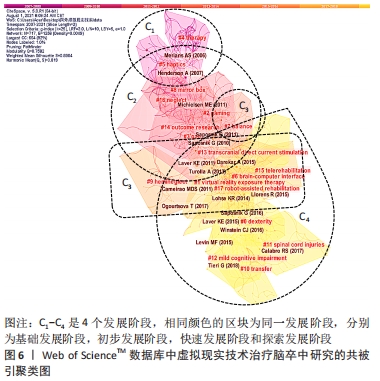

根据图6,图谱中形成了C1-C4共4个发展阶段,根据时间先后顺序,C1是早期形成的知识基础,C2-C4代表发展的前沿方向。C1包括#4:治疗(therapy)、#5:触觉(haptics),为基础发展阶段;C2是初步发展阶段,包括#2:虚拟游戏(gaming)、#3:生成式对抗网络游戏(gan)、#8:镜盒(mirror box)、#14:实效研究(outcome research)、#16:忽视(neglect);C3为快速发展阶段,包括#6:脑-机接口(brain-computer interface)、#7:平衡(balance)、#9:偏瘫(hemineglect)、#13:颈颅直流电刺激(transcranial direct current stimulation)、#15:远程康复(telerehabilitation);C4是探究发展阶段,包括#0:灵巧(dexterity)、#1:虚拟现实暴露疗法(virtual reality exposure therapy)、#10:转移(transfer)、#11:脊髓损伤(spinal cord injuries)、#12:轻度认知功能障碍(mild cognitive impairment)、#17:机器人辅助康复(robot-assisted rehabilitation)。 C1基础阶段的高被引文献是Stroke Care 2: Stroke rehabilitation,文章在2011年综述了当时主要的康复措施,并提出了研究展望,对于治疗脑卒中这种全球高致死、致残率的疾病,虚拟现实技术在未来可以提供很好的康复策略[76],因此学者们以此为基础展开了虚拟现实技术治疗脑卒中的探索。随后Giggins等[77]综述了生物反馈法在康复中的应用,并提出虚拟现实技术通过视觉、触觉声音等方式,也可作为生物反馈的信号,且可改善脑卒中人群的肌肉能力,随后指出还应进一步虚拟现实作为生物反馈信号在不同临床人群中的应用。因此这一阶段虚拟现实治疗脑卒中的初步尝试,为后续学者研究虚拟现实技术治疗脑卒中指明了方向。 C2在C1阶段的基础上,将具体的VR技术初步应用到治疗脑卒中疾病中。这一阶段高被引文献共5篇。DA Silva Cameir?o等[78]将RGS虚拟游戏系统用于临床治疗,并将动作执行和观察的概念与自动个性化训练相结合,发现提升了患者麻痹手臂的动作速度;SHIN等[79]则是比较了三维VE和PE对不同程度患者的康复效果,发现三维虚拟游戏系统对于手部轻度障碍的患者疗效最佳。POLLOCK等[80]则是将虚拟现实技术和镜像疗法相结合用于治疗幻肢疼痛。Saposnik等[81]采用单盲实验法对比了虚拟现实技术和娱乐疗法对治疗脑卒中的安全性,发现虚拟现实技术安全性更好。与之相比,BUXBAUM等[82]通过虚拟现实轮椅车导航技术对9例右半球脑卒中患者进行了侧化空间注意与忽视测试,在被指引的虚拟路径中参与任务训练,发现虚拟现实测试能够指引复杂的路径,且患者驾驶员对该路径训练表现较为敏感,该虚拟现实技术任务有望成为现实生活中灵敏、有效的康复训练手段。这一阶段利用简单的虚拟现实技术康复类游戏成为学者们研究的主题。 正是由于C2阶段虚拟现实技术治疗脑卒中疾病得到了较好的效果,所以学者们在C2的基础上除坚持治疗脑卒中外,还尝试开发更加方便和先进的技术,同时也在探索联合其他疗法共同治疗脑卒中疾病,促使C3进入到快速发展阶段。此阶段的身体能力的恢复、联合疗法的效果及更为方便的技术探讨成为研究的主题。涉及了MILLAN、Gil-Gómez、Golomb、LEE和EKELAND的共5篇高被引文献。其中MILLAN等[83]主要将BCI技术与AT相结合,利用用户心理状态进行BCI可靠性和信度测量、在人机交互中引入原则以提高BCI可用性;Gil-Gómez等[84]推出了eBaViR系统,是将虚拟现实技术结合站立平衡板训练脑卒中患者平衡能力,研究发现该方法能有效改善患者的静态平衡和动态平衡能力;Golomb等[85]发现远程虚拟现实技术康复能有效促进偏瘫青少年的手功能和前臂骨健康;LEE等[86]证实将虚拟现实技术和经颅直流电刺激结合比单独的VR技术更有利脑卒中患者运动能力的恢复;EKELAND等[87]则提出远程康复医疗对于脑卒中患者更加便捷且居家就能实现,通过远程指导、监控和收集数据也能使患者获得不错的恢复效果。 伴随着科技的不断进步,也为了更好地康复脑卒中患者,因此学者们将目光投向更加方便、智能的虚拟现实技术,由此形成了对特殊脑卒中类型和新方法研究的C4探究发展阶段群体。此阶段中涉及了Piron、Opri?、Mouawad、Cheung、 PARK和MACIEJASZ的高被引文献。其中,Piron等[88]调查了患者对居家式远程康复方式的满意度,结果显示大多数患者对于这种灵巧便捷的新型康复方式比较喜欢;Opri?等[89]提出创伤后应激障碍对患者的危害极大,因此其将暴露疗法结合虚拟现实技术用于治疗创伤后应激障碍,通过荟萃分析系统综述了焦虑障碍患者中虚拟现实暴露疗法的效果,为心理障碍的脑卒中患者提供了新方法;Mouawad等[90]探讨了任天堂Wii游戏对脑卒中患者恢复的疗效,发现脑卒中患者的平均运动日志(运动质量量表)得分从63.2增加到87.5,反映了功能恢复向日常活动的转移;Cheung等[91]提出脑卒中后会造成运动皮质损伤,损伤会干扰脊髓神经元的信号传递,造成运动障碍,因此其使用因子分解算法识别肌肉协同运动,发现肌肉的信号因不同障碍程度、不同卒中发作时间的变化而变化,因此这些不同的模式可以用于辨析创伤患者状态的生理标志;PARK等[92]指出混合现实技术结合了虚拟现实技术和增强现实方法,并探讨了对治疗轻度认知障碍的有效性,指出该方法可作为认知训练工具,改善轻度认知障碍患者的视觉空间的工作记忆;MACIEJASZ等[93]则是基于康复师和护理人员短缺的现实情况下,综述了机器人辅助治疗设备,并讨论了应用领域、目标群体、辅助类型、机械设计、控制策略和临床评价等内容,为今后辅助机器人的研究和发展提供了方向。C1-C4不断承前启后式的发展过程表明了虚拟现实技术不断突破创新的脉络演进过程,该技术后续的虚拟技术与其他疗法的结合、远程康复、脑卒中损伤程度的辨别、机器人辅助康复系统的研发将是未来可能的发展趋势。"

| [1] BRAININ M. Stroke epidemiology in China: which are the next steps?. Lancet Neurol. 2019;18(4):325-326. [2] 刘书轩,邱鹏,聂永琦,等.虚拟现实在脑卒中患者运动功能康复中的应用[J].计算机工程与应用,2021(14):1-13. [3] 梁明,窦祖林,邱雅贤.虚拟现实技术在脑损伤后运动障碍康复中的应用[J].中华脑科疾病与康复杂志(电子版),2012, 2(4):33-38. [4] SRAMKA M, LACKO J, RUZICKY E, et al. Combined methods of rehabilitation of patients after stroke: Virtual reality and traditional approach. Neuro Endocrinology Letters. 2020;41(3):123-133. [5] LEE S, KIM Y, LEE BH. Effect of virtual reality-based bilateral upper extremity training on upper extremity function after stroke:a randomized controlled clinical trial. Occup Ther Int. 2016;23(4):357-368. [6] SAPOSNIK G, COHEN LG, MAMDANI M, et al. Efficacy and safety of non-immersive virtual reality exercising in stroke rehabilitation(EVREST):a randomised, multicentre, single-blind,controlled trial. Lancet Neurol. 2016;15(10):1019-1017. [7] GIVON N, ZEILIG G, WEINGARDEN H, et al. Video-games used in a group setting is feasible and effective to improve indicators of physical activity in individuals with chronic stroke:a randomized controlled trial. Clin Rehabil. 2016;30(4):383-392. [8] CHOI JH, HAN EY, KIM BR, et al. Effectiveness of commercial gaming-based virtual reality movement therapy on functional recovery of upper extremity in subacute stroke patients. Ann Rehabil Med. 2014;38(4):485-493. [9] GEORGIOU AM, IOANNIS P, CHRYSA G, et al. Can transcranial magnetic stimulation (TMS) facilitate language recovery in chronic global aphasia poststroke? Evidence from a case study. Neurolinguistics. 2020;55: 100907. [10] 张家铭,田艳萍,张月,等.经颅磁刺激治疗脑卒中的Citespace知识图谱可视化分析[J].中国组织工程研究,2021,25(35):5610-5618. [11] 霍炫伊,石岩.体育领域CiteSpace类研究信度、效度影响因素及其控制[J].中国体育科技,2018,54(6):45-51+67. [12] 刘则渊,陈悦,侯海燕.科学知识图谱:方法与应用[M].北京:人民出版社. 2008. [13] ODERMATT IA, BUETLER KA, WENK N, et al. Congruency of Information Rather Than Body Ownership Enhances Motor Performance in Highly Embodied Virtual Reality. Front Neurosc. 2021;15:678909. [14] LLORENS R, FUENTES MA, BORREGO A, et al. Effectiveness of a combined transcranial direct current stimulation and virtual reality-based intervention on upper limb function in chronic individuals post-stroke with persistent severe hemiparesis: a randomized controlled trial. J Neuroeng Rehabil. 2021;18(1):108. [15] KELLER J, ŠTĚTKÁŘOVÁ I, MACRI V, et al. Virtual reality-based treatment for regaining upper extremity function induces cortex grey matter changes in persons with acquired brain injury. J Neuroeng Rehabil. 2020;17(1):127. [16] HUSSAIN N, SUNNERHAGEN KS, ALT MURPHY M. End-point kinematics using virtual reality explaining upper limb impairment and activity capacity in stroke. J Neuroeng Rehabil. 2019;16(1):82. [17] QIU Q, CRONCE A, PATEL J, et al. Development of the Home based Virtual Rehabilitation System (HoVRS) to remotely deliver an intense and customized upper extremity training. J Neuroeng Rehabil. 2020;17(1):155. [18] TRIANDAFILOU KM, TSOUPIKOVA D, BARRY AJ, et al. Development of a 3D, networked multi-user virtual reality environment for home therapy after stroke. J Neuroeng Rehabil. 2018;15(1):88. [19] KIM A, SCHWEIGHOFER N, FINLEY JM. Locomotor skill acquisition in virtual reality shows sustained transfer to the real world. J Neuroeng Rehabil. 2019;16(1):113. [20] PIROVANO M, SURER E, MAINETTI R, et al. Exergaming and rehabilitation: A methodology for the design of effective and safe therapeutic exergames. Entertainment Computing. 2016;14:55-65. [21] LAI CL, TSENG CM, ERDENETSOGT D, et al. A Kinect-Based System for Balance Rehabilitation of Stroke Patients. The Institute of Electronics, Information and Communication Engineers. 2016;D(4):E99. [22] MA S, VARLEY M, SHARK LK, et al. Overcoming the information overload problem in a multiform feedback-based virtual reality system for hand motion rehabilitation: healthy subject case study. Virtual Reality. 2012;16(4):325-334. [23] 杨雨洁,岳雨珊,郭佳宝,等. 虚拟现实技术对脑卒中患者上下肢运动功能康复效果的系统评价[J].中国康复理论与实践,2013, 19(8):710-721. [24] MAGGIO MG, LATELLA D, MARESCA G, et al. Virtual Reality and Cognitive Rehabilitation in People With Stroke: An Overview. J Neurosci Nurs. 2019;51(2):101-105. [25] 肖湘,毛玉瑢,李乐,等.虚拟现实与同步减重训练对脑卒中患者步态影响的对照研究[J].中国康复医学杂志,2012,27(6):533-537. [26] 容小川,张盘德,刘翠华,等.虚拟现实技术治疗对脑卒中患者上肢功能障碍的疗效[J].实用医学杂志,2015,31(11):1807-1809. [27] 刘翠华,张盘德,容小川,等.功能性电刺激同步虚拟现实技术对脑卒中患者下肢运动功能障碍的影响[J].中国康复医学杂志,2014, 29(8):736-739. [28] 赵丙军.国外力量训练研究知识网络的结构及演化特征[D].上海:上海体育学院,2013. [29] SAPOSNIK G, MCILROY WE, TEASELL R, et al. Effectiveness of virtual reality using Wii gaming technology in stroke rehabilitation:a pilot randomized clinical trial and proof of principle. Stroke. 2010;41(7): 1477-1484. [30] KWAKKEL G, KOLLEN B J, GROND J, et al. Probability of Regaining Dexterity in the Flaccid Upper Limb: Impact of Severity of Paresis and Time Since Onset in Acute Stroke. Stroke. 2003;34(9):2181-2186. [31] ERHARDSSON M, MURPHY MA, SUNNERHAGEN KS. Commercial head-mounted display virtual reality for upper extremity rehabilitation in chronic stroke: a single-case design study. J Neuroeng Rehabil. 2020; 17(1):1-14. [32] WEBER LM, NILSEN DM, GILLEN G, et al. Immersive Virtual Reality Mirror Therapy for Upper Limb Recovery After Stroke: A Pilot Study. Am J Phys Med Rehabil. 2019;98(9):783-788. [33] CROSBIE J, LENNON S, MCGOLDRICK M, et al. Virtual reality in the rehabilitation of the arm after hemiplegic stroke: a randomized controlled pilot study. Clin Rehabil. 2012;26(9):798-806. [34] JIN N, JAYASHREE AK, PILWON H, et al. Usability evaluation of low-cost virtual reality hand and arm rehabilitation games. J Rehabil Res Dev. 2016;53(3):321-334. [35] HUNG JW, CHOU CX, CHANG YJ, et al. Comparison of Kinect2Scratch game-based training and therapist-based training for the improvement of upper extremity functions of patients with chronic stroke: a randomized controlled single-blinded trial.Eur j J Phys Rehabil Med. 2019;(5):542-550. [36] NOROUZI-GHEIDARI N, HERNANDEZ A, ARCHAMBAULT PS, et al. Feasibility, safety and efficacy of a virtual reality exergame system to supplement upper extremity rehabilitation post-stroke: A pilot randomized clinical trial and proof of principle. Int J Environ Res Public Health. 2020;17(1):113. [37] LLORENS R, FUENTES MA, BORREGO A, et al. Effectiveness of a combined transcranial direct current stimulation and virtual reality-based intervention on upper limb function in chronic individuals post-stroke with persistent severe hemiparesis: a randomized controlled trial. J Neuroeng Rehabil. 2021;18(1):108. [38] NOROUZI-GHEIDARI N, ARCHAMBAULT PS, MONTE-SILVA K ,et al. Feasibility and preliminary efficacy of a combined virtual reality, robotics and electrical stimulation intervention in upper extremity stroke rehabilitation. J Neuroeng Rehabil. 2021;18(1):61. [39] CHEN YH, CHEN CL, HUANG YZ, et al. Augmented efficacy of intermittent theta burst stimulation on the virtual reality-based cycling training for upper limb function in patients with stroke: a double-blinded, randomized controlled trial. J Neuroeng Rehabil. 2021;18(1):91. [40] WANG ZR, PING W,XING L, et al. Leap Motion-based virtual reality training for improving motor functional recovery of upper limbs and neural reorganization in subacute stroke patients. Neural Regen Res. 2017;12(11):1823-1831. [41] FLUET GG, PATEL J, QIU Q, et al. Motor skill changes and neurophysiologic adaptation to recovery-oriented virtual rehabilitation of hand function in a person with subacute stroke: a case study. Disabil Rehabil. 2017;39(15):1524-1531. [42] LANSBERG MG, LEGAULT C, MACLELLAN A, et al. Home-based Virtual Reality Therapy for Hand Recovery After Stroke. PM R. 2021. doi: 10.1002/PMRJ.12598. [43] WILLETT FR, AVANSINO DT, HOCHBERG LR, et al. High-performance brain-to-text communication via handwriting. Nature. 2021;593(7858):249-254. [44] VOURVOPOULOS A, PARDO OM, LEFEBVRE S, et al. Effects of a brain-computer interface with virtual reality (VR) neurofeedback: A pilot study in chronic stroke patients. Front Hum Neurosci. 2019;13:210. [45] CAI H, LIN T, CHEN L, et al. Evaluating the effect of immersive virtual reality technology on gait rehabilitation in stroke patients: a study protocol for a randomized controlled trial. Trials. 2021;22(1):91. [46] MARQUES-SULE E, ARNAL-GÓMEZ A, BUITRAGO-JIMÉNEZ G, et al. Effectiveness of Nintendo Wii and Physical Therapy in Functionality, Balance, and Daily Activities in Chronic Stroke Patients. J Am Med Dir Assoc. 202;22(5):1073-1080. [47] ASLAM M, AIN QU, FAYYAZ P, et al. Exer-gaming reduces fall risk and improves mobility after stroke. J Pak Med Assoc. 2021;71(6):1673-1675. [48] KIM MJ. Virtual Reality Community Gait Training Using a 360° Image Improves Gait Ability in Chronic Stroke Patients. J Korean Phys Ther. 2020;32(3):185-190. [49] ZAKHAROV AV, BULANOV VA, KHIVINTSEVA EV, et al. Stroke Affected Lower Limbs Rehabilitation Combining Virtual Reality With Tactile Feedback. Front Robot AI. 2020;7:81. [50] PARK S, LEE D, HONG S, et al. Feasibility of training using full immersion virtual reality video game in a young stroke survivor: A case report. NeuroRehabilitation. 2021;48(1)1-8. [51] BONUZZI GMG, DE FREITAS TB, PALMA GCDS, et al. Effects of the brain-damaged side after stroke on the learning of a balance task in a non-immersive virtual reality environment. Physiother Theory Pract. 2020:1-8. [52] SOLANKI D, LAHIRI U. Adaptive Treadmill-Assisted Virtual Reality-Based Gait Rehabilitation for Post-Stroke Physical Reconditioning - A Feasibility Study in Low-Resource Settings. IEEE Access. 2020;8:1-1. [53] WALKER ML, RINGLEB SI , MAIHAFER GC, et al. Virtual reality–enhanced partial body weight–supported treadmill training poststroke: feasibility and effectiveness in 6 subjects. Arch Phys Med Rehabil. 2010;91(1):115-122. [54] BAE S, LEE J, LEE BH. Effect of an EMG-FES Interface on Ankle Joint Training Combined with Real-Time Feedback on Balance and Gait in Patients with Stroke Hemiparesis. Healthcare (Basel). 2020;8(3):292. [55] MANULI A, MAGGIO MG, LATELLA D, et al. Can robotic gait rehabilitation plus Virtual Reality affect cognitive and behavioural outcomes in patients with chronic stroke? A randomized controlled trial involving three different protocols. J Stroke Cerebrovascular Dis. 2020;29(8):104994. [56] JAHN FS, SKOVBYE M, OBENHAUSEN K, et al. Cognitive training with fully immersive virtual reality in patients with neurological and psychiatric disorders: A systematic review of randomized controlled trials. Psychiatry Res. 2021;300:113928. [57] DAREKAR A, MCFADYEN BJ, LAMONTAGNE A, et al. Efficacy of virtual reality-based intervention on balance and mobility disorders post-stroke: a scoping review. J Neuroeng Rehabil. 2015;12:46. [58] YEH SC, LEE SH, CHAN RC, et al. A virtual reality system integrated with robot-assisted haptics to simulate pinch-grip task:Motor ingredients for the assessment in chronic strok. NeuroRehabilitation. 2014;35(3):435-449. [59] BOONE AE, MORGAN KA, ENGSBERG JR. A new combined motor and cognitive strategy training intervention for stroke:Stakeholder perceptions. British Journal of Occupational Therapy. 2017;80(12): 726-734. [60] HWANG NK, CHOI JB, CHOI DK, et al. Effects of Semi-Immersive Virtual Reality-Based Cognitive Training Combined with Locomotor Activity on Cognitive Function and Gait Ability in Community-Dwelling Older Adults[J]. Healthcare (Basel). 2021;9(7):814. [61] 詹青,王丽晶.2016 AHA/ASA成人脑卒中康复治疗指南解读[J].神经病学与神经康复学杂志,2017,13(1):1-9. [62] 赵一瑾,余彬,何龙龙,等.虚拟现实技术结合作业治疗训练对脑卒中偏瘫患者上肢功能影响的临床研究[J].中国康复医学杂志, 2019,34(6):661-666. [63] 田然,柏敏,马腾.虚拟现实技术对脑卒中患者上肢功能及日常生活活动能力的效果[J].中国康复理论与实践,2016,22(12):1371-1374. [64] 危昔均,韦亦茜,秦萍,等.基于沉浸式虚拟现实脑卒中偏瘫上肢功能康复系统构建及临床可行性研究[J].中西医结合心脑血管病杂志,2021,19(11):1949-1952. [65] 梁明,巴玉兰,谢荣,等.虚拟现实技术对脑卒中患者手功能康复效果的meta分析[J].中国康复医学杂志,2020,35(4):470-474. [66] 张桃,杨帮华,段凯文,等.基于运动想象脑机接口的手功能康复系统设计[J].中国康复理论与实践,2017,23(1):4-9. [67] 肖湘,毛玉瑢,赵江莉,等.虚拟现实同步减重训练脑梗死患者可改善下肢运动功能[J].中国组织工程研究,2014,18(7):1143-1148. [68] 滕树利,张芳,吴月峰.虚拟现实技术对脑卒中偏瘫患者平衡功能的影响[J].中国康复医学杂志,2019,34(8):932-936. [69] 孙然,张通,赵军,等.虚拟现实技术对脑卒中偏瘫患者平衡功能的疗效[J].中国康复理论与实践,2014,20(5):458-463. [70] 孙然,张通.虚拟现实技术在脑卒中患者平衡功能康复的应用[J].中国康复理论与实践,2014,20(1):37-40. [71] 张星星,王筱筱,段宏为,等.虚拟现实技术在卒中康复中的研究进展[J].中国脑血管病杂志,2018,15(6):322-326. [72] 李龙飞,曹飞帆,张鑫,梁仍昊,徐光华.脑控主被动协同刺激下肢康复训练系统研究与开发[J].西安交通大学学报(医学版),2019, 40(1):130-133+143. [73] 刘婷婷,刘箴,钱平安,等.虚拟现实在特殊人群康复中的应用研究[J].系统仿真学报,2018,30(9):3229-3237. [74] CHEN C. CiteSpace Ⅱ: Detecting and visualizing emerging trends and transient patterns in scientific literature. Journal of the China Society for Scientific & Technical Information. 2014;57(3):359-377. [75] 陈悦,陈超美,刘则渊,等. CiteSpace 知识图谱的方法论功能[J].科学学研究,2015,33(2):242-253. [76] PETER L, JULIE B, GERTK W. Stroke Care2:Strokerehabilitation. Lancet. 2011;377(9778):1693-1702. [77] GIGGINS OM, PERSSON UM, CAULFIELD B. Biofeedback in rehabilitation. J Neuroeng Rehabil. 2013;10:60. [78] DA SILVA CAMEIRÃO M, BERMÚDEZ I BADIA S, DUARTE E, et al. Virtual reality based rehabilitation speeds up functional recovery of the upper extremities after stroke: A randomized controlled pilot study in the acute phase of stroke using the Rehabilitation Gaming System. Restor Neurol Neurosci. 2011;29(5):287-298. [79] SHIN JH, RYU H, JANG SH. A task-specific interactive game-based virtual reality rehabilitation system for patients with stroke: a usability test and two clinical experiments. J Neuroeng Rehabil. 2014,11(1):32. [80] POLLOCK A, FARMER SE, BRADY MC, et al. Interventions for improving upper limb function after stroke. Cochrane Database Syst Rev. 2014;2014(11):CD010820. [81] SAPOSNIK G, TEASELL R, MAMDANI M, et al. Effectiveness of virtual reality using wii gaming technology in stroke rehabilitation: A pilot randomized clinical trial and proof of principle. Stroke. 2010;41(7):1477-1484. [82] BUXBAUM LJ, PALERMO MA, MASTROGIOVANNI D, et al. Assessment of spatial attention and neglect with a virtual wheelchair navigation task. J Clin Exp Neuropsychol. 2008;30(6):650-660. [83] MILLÁN JD, RUPP R, MÜLLER-PUTZ GR, et al. Combining brain-computer interfaces and assistive technologies: state-of-the-art and challenges. Front Neurosci. 2010;4:161. [84] GIL-GÓMEZ JA, LLORÉNS R, ALCAÑIZ M, et al. Effectiveness of a Wii balance board-based system (eBaViR) for balance rehabilitation: a pilot randomized clinical trial in patients with acquired brain injury. J Neuroeng Rehabil. 2011;8:30. [85] GOLOMB MR, MCDONALD BC, WARDEN SJ, et al. In-Home Virtual Reality Videogame Telerehabilitation in Adolescents With Hemiplegic Cerebral Palsy. Arch Phys Med Rehabil. 2010;91(1):1-8. [86] LEE SJ, CHUN MH. Combination Transcranial Direct Current Stimulation and Virtual Reality Therapy for Upper Extremity Training in Patients With Subacute Stroke. Arch Phys Med Rehabil. 2014;95(3):431-438. [87] EKELAND AG, BOWES A, FLOTTORP S. Effectiveness of telemedicine: a systematic review of reviews. Int J Med Inform. 2010,79(11):736-771. [88] PIRON L, TUROLLA A, TONIN P, et al.Satisfaction with care in post-stroke patients undergoing a telerehabilitation programme at home. J Telemed Telecare. 2008;14(5):257-260. [89] OPRIŞ D, PINTEA S, GARCÍA-PALACIOS A, et al. Virtual reality exposure therapy in anxiety disorders:a quantitative meta-analysis. Depress Anxiety. 2012;29(2):85-93. [90] MOUAWAD MR, DOUST CG, MAX MD, et al. Wii-based movement therapy to promote improved upper extremity function post-stroke: A pilot study. J Rehabil Med. 2011;43(6):527-533. [91] CHEUNG VC, TUROLLA A, AGOSTINI M, et al. Muscle synergy patterns as physiological markers of motor cortical damage. Proc Natl Acad Sci U S A. 2012;109(36):14652-14656. [92] PARK E, YUN BJ, MIN YS, et al. Effects of a Mixed Reality-based Cognitive Training System Compared to a Conventional Computer-assisted Cognitive Training System on Mild Cognitive Impairment: A Pilot Study. Cogn Behav Neurol. 2019;32(3):172-178. [93] MACIEJASZ P, ESCHWEILER J, GERLACH-HAHN K, et al. A survey on robotic devices for upper limb rehabilitation. J Neuroeng Rehabil. 2014;11:3. |
| [1] | Zhao Jing, Liu Xiaobo, Zhang Yue, Zhang Jiaming, Zhong Dongling, Li Juan, Jin Rongjiang. Visualization analysis of neuromuscular electrical stimulation therapy based on CiteSpace: therapeutic effects, hot spots, and developmental trends [J]. Chinese Journal of Tissue Engineering Research, 2022, 26(8): 1234-1241. |
| [2] | Tang Wenjing, Wu Siyuan, Yang Chen, Tao Xi. Inflammatory responses in post-stroke depression [J]. Chinese Journal of Tissue Engineering Research, 2022, 26(8): 1278-1285. |
| [3] | Fang Xiaolei, Leng Jun, Zhang Chen, Liu Huimin, Guo Wen. Systematic evaluation of different therapeutic effects of mesenchymal stem cell transplantation in the treatment of ischemic stroke [J]. Chinese Journal of Tissue Engineering Research, 2022, 26(7): 1085-1092. |
| [4] | Zhang Jinglin, Leng Min, Zhu Boheng, Wang Hong. Mechanism and application of stem cell-derived exosomes in promoting diabetic wound healing [J]. Chinese Journal of Tissue Engineering Research, 2022, 26(7): 1113-1118. |
| [5] | Gao Yujin, Peng Shuanglin, Ma Zhichao, Lu Shi, Cao Huayue, Wang Lang, Xiao Jingang. Osteogenic ability of adipose stem cells in diabetic osteoporosis mice [J]. Chinese Journal of Tissue Engineering Research, 2022, 26(7): 999-1004. |
| [6] | Li Guijun, Fang Xiaohui, Kong Weifeng, Yuan Xiaoqing, Jin Rongzhong, Yang Jun. Finite element analysis of the treatment of hallux valgus deformity by microplate combined with super strong suture elastic fixation [J]. Chinese Journal of Tissue Engineering Research, 2022, 26(6): 938-942. |
| [7] | Fan Jianchao, Xu Paidi, Han Yongli, Wen Caiyuzhu, Zhang Hongxing, Pan Xiaoli. Effects of electroacupuncture at Zusanli acupoint on visceral hypersensitivity in rats with functional dyspepsia [J]. Chinese Journal of Tissue Engineering Research, 2022, 26(5): 663-668. |
| [8] | Dong Miaomiao, Lai Han, Li Manling, Xu Xiuhong, Luo Meng, Wang Wenhao, Zhou Guoping. Effect of electroacupuncture on expression of nucleotide binding oligomerization domain-like receptor protein 3/cysteinyl aspartate specific proteinase 1 in rats with cerebral ischemia/reperfusion injury [J]. Chinese Journal of Tissue Engineering Research, 2022, 26(5): 749-755. |
| [9] | Lu Qinxue, Xu Ning, Yang Yinglan, Han Qianqian, Duanmu Xianyu, Guo Yuwei, Han Qing. Femoroacetabular impingement: strength trainings for nerve-muscle, peripheral muscle and core muscle [J]. Chinese Journal of Tissue Engineering Research, 2022, 26(5): 786-791. |
| [10] | Huang Shibo, Xie Hui, Wang Zongpu, Wang Weidan, Qin Kairong, Zhao Dewei. Application of degradable high-purity magnesium screw in the treatment of developmental dysplasia of the hip [J]. Chinese Journal of Tissue Engineering Research, 2022, 26(4): 493-498. |
| [11] | He Yunying, Li Lingjie, Zhang Shuqi, Li Yuzhou, Yang Sheng, Ji Ping. Method of constructing cell spheroids based on agarose and polyacrylic molds [J]. Chinese Journal of Tissue Engineering Research, 2022, 26(4): 553-559. |
| [12] | Wang Ruanbin, Cheng Liqian, Chen Kai. Application and value of polymer materials in three-dimensional printing biological bones and scaffolds [J]. Chinese Journal of Tissue Engineering Research, 2022, 26(4): 610-616. |
| [13] | Zhang Tong, Cai Jinchi, Yuan Zhifa, Zhao Haiyan, Han Xingwen, Wang Wenji. Hyaluronic acid-based composite hydrogel in cartilage injury caused by osteoarthritis: application and mechanism [J]. Chinese Journal of Tissue Engineering Research, 2022, 26(4): 617-625. |
| [14] | Wang Chong, Zhang Meiying, Zhou Jian, Lao Kecheng. Early gait changes after total hip arthroplasty through direct anterior approach and posterolateral approach [J]. Chinese Journal of Tissue Engineering Research, 2022, 26(3): 359-364. |
| [15] | Liu Yubo, Zhang Huizeng, Zhang Tongrun, Sui Gengyi, Ma Nan, Cheng Xu, Gao Xupeng, Xu Jing, Wang Chaoliang. Correlation analysis between the morphological changes of ankle acupoints and the ankle function after ankle fracture surgery [J]. Chinese Journal of Tissue Engineering Research, 2022, 26(3): 440-445. |
| Viewed | ||||||
|
Full text |
|
|||||
|
Abstract |
|
|||||
